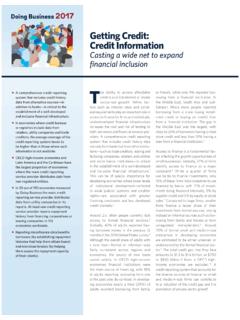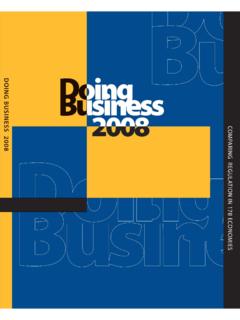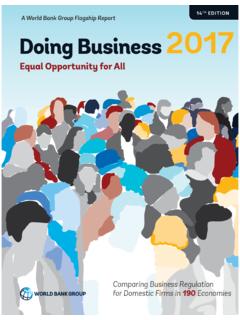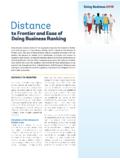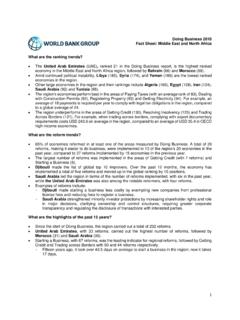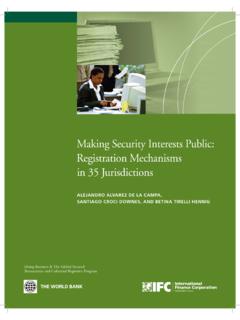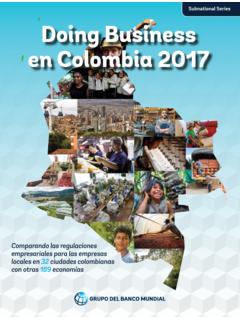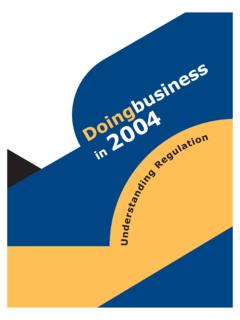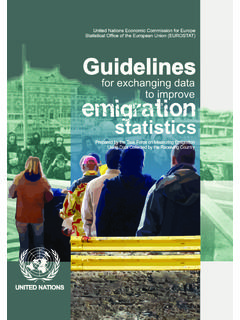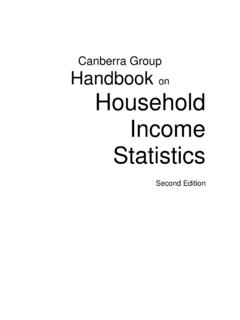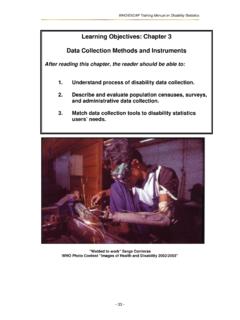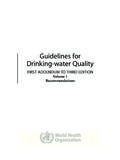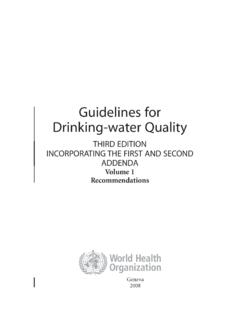Transcription of Women’s Entrepreneurship - Measuring Business …
1 Policy Research Working Paper8242 women s EntrepreneurshipHow to Measure the Gap between New Female and Male Entrepreneurs?Fr d ric MeunierYulia KrylovaRita RamalhoDevelopment Economics Global Indicators GroupNovember 2017 WPS8242 Public Disclosure AuthorizedPublic Disclosure AuthorizedPublic Disclosure AuthorizedPublic Disclosure AuthorizedProduced by the Research Support TeamAbstractThe Policy Research Working Paper Series disseminates the findings of work in progress to encourage the exchange of ideas about development issues. An objective of the series is to get the findings out quickly, even if the presentations are less than fully polished. The papers carry the names of the authors and should be cited accordingly. The findings, interpretations, and conclusions expressed in this paper are entirely those of the authors.
2 They do not necessarily represent the views of the International Bank for Reconstruction and Development/World Bank and its affiliated organizations, or those of the Executive Directors of the World Bank or the governments they Research Working Paper 8242 This paper is a product of the Global Indicators Group, Development Economics. It is part of a larger effort by the World Bank to provide open access to its research and make a contribution to development policy discussions around the world. Policy Research Working Papers are also posted on the Web at The authors may be contacted at This paper analyzes data on female and male entrepre-neurship that were collected by the World Bank Group s Entrepreneurship Database. Recognizing the importance of a differentiated approach to Entrepreneurship in terms of legal entities, the data on female and male Business owners are collected at the level of limited liability companies and sole proprietorships.
3 Forty-four of the 143 economies that participated in the Entrepreneurship project provided some sex-disaggregated data for 2016. The paper finds that the gender gap in Business ownership remains high in many economies around the world. In the majority of the ana-lyzed economies, less than one-third of new limited liability company owners are women . Although sole proprietorships are more frequently used by female entrepreneurs, only three economies have similar or equal number of women Business owners relative to men. The gap in female entre-preneurship is especially apparent in low-income economies, where women are much less likely than men to start a new Business . The paper also provides new insights into the relationship between female Entrepreneurship and various institutional factors, including women s financial inclusion, the gender gap in education, and legal rights disparities.
4 The analysis suggests a need to expand the collection of sex-disaggregated data, to trace the economies progress in narrowing the existing gender gap in s Entrepreneurship : How to Measure the Gap between New Female and Male Entrepreneurs? Fr d ric Meunier Yulia Krylova Rita Ramalho JEL: L26, J16 Keywords: Female Entrepreneurship , Business ownership, gender gap The data collection was made possible thanks to the work of Aure Demoulin, Marianne Petrosyan, Tatyana Sydorenko, Enrique Yepiz Mendivil and Han Seul Yoon. The authors are very thankful to Noa Catalina Gimelli, Anja Robakowski-Van Stralen, Santiago Croci Downes, Sarah Iqbal, Asif Mohammed Islam and Alice Ouedraogo for helpful discussions and comments. The authors are especially grateful to the Department for International Development (DFID) for providing financial support making the collection and dissemination of the sex-disaggregated data on female Entrepreneurship possible.
5 2 1. Introduction women s economic empowerment is a cornerstone of the 2030 Agenda for Sustainable Development. The 2016 Report of the United Nations Secretary-General s High-Level Panel on women s Economic Empowerment provides strong evidence that women are lagging behind men in terms of the number of female Business owners, the size of women -owned businesses, and their access to economic resources. Specifically, women -owned enterprises are smaller and disadvantaged in their access to credit, resources, and assets (UN Secretary-General s High-Level Panel on women s Economic Empowerment 2016, 2). With data on the existing gender gap in female Entrepreneurship sparse, tracking the progress achieved by women in this area becomes more important. Cross-country comparisons are essential for in-depth analysis of the development of female Entrepreneurship in different institutional, legal and socio-cultural environments.
6 Measuring women s entrepreneurial activity is critically important for a better understanding of how female entrepreneurs contribute to the economy and society. However, there are few data sets related to female Entrepreneurship with comparable cross-country data. To address this issue, the 2017 edition of the World Bank Group s Entrepreneurship Database expanded its scope to collect comparable cross-country data on the number of new female and male LLC owners and sole proprietors. The importance of female Entrepreneurship for economic development is widely recognized. Numerous studies demonstrate the positive impact of female entrepreneurs on economic growth and development, as well as sustainable and durable peace (Cuberes and Teignier 2014; Fetsch, Jackson, and Wiens 2015; Lewis et al.)
7 2014; Woetzel et al. 2015). Moreover, economies characterized by high levels of female entrepreneurial activity are more resilient to financial crises and experience economic slowdowns less frequently (Global Entrepreneurship Research Association 2017, 29). Despite different methodologies, these studies find significant socioeconomic benefits of female Entrepreneurship . According to Woetzel et al. (2015), a full-potential scenario in which women participate in the economy identically to men would contribute as much as $28 trillion, or 26 percent, to annual global GDP by 2025. Currently, the potential of female entrepreneurs is not fully realized in many economies. Indeed, an analysis of 15 gender indicators across 95 economies shows that 46 of these economies have very high levels of gender inequality on more than half of the indicators (ibid.
8 Another cross-country study demonstrates that gender gap-related income losses differ by geographical region (Cuberes and Teignier 2014). Economies in the Middle East and North Africa have the highest income loss associated with lower economic opportunities for women (27 percent); in Europe, this loss is less than 10 percent (ibid., 21). This study provides further evidence of gender gaps in female Business entry and ownership in many economies worldwide. Indeed, less than one-third of LLC owners are women in the vast majority of economies. Although sole proprietorships are more frequently used by female entrepreneurs, only three economies have similar or equal numbers of women Business owners relative to men. The study also suggests that the gap in female Entrepreneurship is reinforced by other gender inequalities, such as low financial inclusion of women , the gap in education, and legal rights disparities.
9 Section 2 reviews the coverage and limitations of existing female Entrepreneurship data sets. Section 3 presents the methodology and describes the data collection process, with a particular focus on the new gender-specific indicators. Section 4 consists of a comparative analysis of gender gaps in Business entry and ownership across economies. Section 5 discusses how institutional factors can influence female Entrepreneurship . Specifically, this section analyzes the link between the level of female Entrepreneurship and other factors, including legal barriers for women to doing Business , their level of education and their ability to access bank accounts and capital. 3 2. Female Entrepreneurship and Existing Data Sets The lack of comprehensive sex-disaggregated data on Business entry and ownership presents a significant obstacle to the global and diversified analysis of female Entrepreneurship .
10 Due to insufficient standardized and country-comparable data, the diagnostics of gender gaps in Entrepreneurship are limited. This section offers a brief overview of the existing data sets and indicators commonly used to measure female Entrepreneurship and analyzes their limitations. The Global Entrepreneurship Monitor (GEM) was launched in 1999 and is now carried out by more than 400 experts on Entrepreneurship from over 100 research and academic institutions (Global Entrepreneurship Research Association 2017). The GEM considers the broad definition of Entrepreneurship as any attempt at new Business or new venture creation, such as self-employment, a new Business organization, or the expansion of an existing Business , by an individual, a team of individuals, or an established Business (Reynolds, Hay, and Camp 1999, 3).
